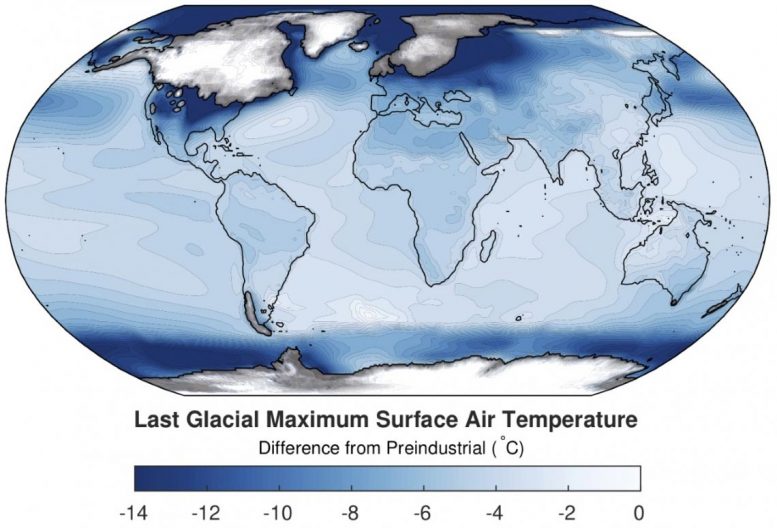
Scientists’ ice age ‘hindcast’ may shed light on future climate.
A University of Arizona-led team has nailed down the temperature of the last ice age – the Last Glacial Maximum of 20,000 years ago – to about 46 degrees Fahrenheit.
Their findings allow climate scientists to better understand the relationship between today’s rising levels of atmospheric carbon dioxide – a major greenhouse gas – and average global temperature.

The Last Glacial Maximum, or LGM, was a frigid period when huge glaciers covered about half of North America, Europe, and South America and many parts of Asia, while flora and fauna that were adapted to the cold thrived.
“We have a lot of data about this time period because it has been studied for so long,” said Jessica Tierney, associate professor in the University of Arizona Department of Geosciences. “But one question science has long wanted answers to is simple: How cold was the ice age?”
Tracking Temperature
Tierney is lead author of a paper published today (August 26, 2020) in Nature that found that the average global temperature of the ice age was 6 degrees Celsius (11 F) cooler than today. For context, the average global temperature of the 20th century was 14 C (57 F).
“In your own personal experience that might not sound like a big difference, but, in fact, it’s a huge change,” Tierney said.
She and her team also created maps to illustrate how temperature differences varied in specific regions across the globe.
“In North America and Europe, the most northern parts were covered in ice and were extremely cold. Even here in Arizona, there was big cooling,” Tierney said. “But the biggest cooling was in high latitudes, such as the Arctic, where it was about 14 C (25 F) colder than today.”
Their findings fit with scientific understanding of how Earth’s poles react to temperature changes.
“Climate models predict that the high latitudes will get warmer faster than low latitudes,” Tierney said. “When you look at future projections, it gets really warm over the Arctic. That’s referred to as polar amplification. Similarly, during the LGM, we find the reverse pattern. Higher latitudes are just more sensitive to climate change and will remain so going forward.”
Counting Carbon
Knowing the temperature of the ice age matters because it is used to calculate climate sensitivity, meaning how much the global temperature shifts in response to atmospheric carbon.
Tierney and her team determined that for every doubling of atmospheric carbon, the global temperature should increase by 3.4 C (6.1 F), which is in the middle of the range predicted by the latest generation of climate models (1.8 to 5.6 C).
Atmospheric carbon dioxide levels during the ice age were about 180 parts per million, which is very low. Before the Industrial Revolution, levels rose to about 280 parts per million, and today they’ve reached 415 parts per million.
“The Paris Agreement wanted to keep global warming to no larger than 2.7 F (1.5 C) over pre-industrial levels, but with carbon dioxide levels increasing the way they are, it would be extremely difficult to avoid more than 3.6 F (2 C) of warming,” Tierney said. “We already have about 2 F (1.1 C) under our belt, but the less warm we get the better, because the Earth system really does respond to changes in carbon dioxide.”
Making a Model
Since there were no thermometers in the ice age, Tierney and her team developed models to translate data collected from ocean plankton fossils into sea-surface temperatures. They then combined the fossil data with climate model simulations of the LGM using a technique called data assimilation, which is used in weather forecasting.
“What happens in a weather office is they measure the temperature, pressure, humidity and use these measurements to update a forecasting model and predict the weather,” Tierney said. “Here, we use the Boulder, Colorado-based National Center for Atmospheric Research climate model to produce a hindcast of the LGM, and then we update this hindcast with the actual data to predict what the climate was like.”
In the future, Tierney and her team plan to use the same technique to recreate warm periods in Earth’s past.
“If we can reconstruct past warm climates,” she said, “then we can start to answer important questions about how the Earth reacts to really high carbon dioxide levels, and improve our understanding of what future climate change might hold.”
Reference: “Glacial cooling and climate sensitivity revisited” by Jessica E. Tierney, Jiang Zhu, Jonathan King, Steven B. Malevich, Gregory J. Hakim and Christopher J. Poulsen, 26 August 2020, Nature.
DOI: 10.1038/s41586-020-2617-x
The research was supported by the Heisings-Simons Foundation and the National Science Foundation.
6 Comments
Your article has conversion errors. 6 degrees Celsius is 42.8 degrees Fahrenheit not 11 degrees. 3.4 degrees Celsius is 38.12 degrees Fahrenheit not 6.1 degrees. I would think for a supposed science publication this would have been caught immediately. 0 degrees Celsius = 32 degrees Fahrenheit, pretty easy to do a check on those numbers.
While yes, 0ºC is 32ºF, the temperature difference from 0ºC (32ºF) to 1ºC (33.8ºF) is 1º in C (1.8º in F) The numbers given are incremental equivalence not literal equivalence. For instance, as I described, the difference in a change of temperature in 1ºC is 1.8ºF or the other way around a change of temperature in 1º of F is about .556º of C. The math in the article is correct.
My mistake, I misread that. I apologize. It can be confusing mixing the two scales in this sort of comparison though.
Pls re-read the passage. The 6 degrees is a delta from present temperatures. 6C is, in fact, 11F. It sez: “the average global temperature of the ice age was 6 degrees Celsius (11 F) cooler than today. For context, the average global”
What I am about to present will be considered as “you’ve go to be kidding me”. The view as presented in this article that the “Large Glacial Movement” was some 20,000 years ago, should be reconsidered. Why ? Because there is a timeline established in the Bible that assists in grasping when the arctic poles with its ice came into existence.
At Genesis 1, it lays out a graphic representation of time that allows us to understand how the earth was prepared for life over the course of six “creative” days, in which each “creative” day was several thousand years long. And when mankind was introduced some 6,000 years ago at the very end of the sixth “creative” day, the temperature of the earth was very comfortable throughout the earth, even what today is called “the poles”, for fossilized pollen and spores have been found in seabed sediment of the Antarctic Ocean, revealing that it once supported palms and near-tropical forests.(LiveScience, June 28, 2011)
And from a careful consideration of the account at Genesis 6:17, there was “a heavenly ocean” (Heb ham mab bul) that was above the earth (or body of water that is now our present oceans) that God (whose personal name is Jehovah, Ps 83:18) placed there for the benefit of life, keeping the earth’s temperature comfortably warm in all areas, for even in the coldest of places, such as Siberia, woolly mammoths have been found frozen with buttercups between their teeth, showing that it was at one time covered with green vegetation.
And with chronological dating in the Bible, it can be established that a global flood occurred in 2370 B.C.E. because the massive waters or “heavenly ocean” that surrounded the earth in the upper atmosphere, like a warm thermal blanket, were quickly condensed into rain, causing a massive change in temperature especially at the poles, so that what was once a temperate zone where animals of all types thrived now suddenly became a frozen “wasteland”.(Gen 7:6)
It is also well known that hot water freezes quicker than cold water, so that the once temperate zone of the earth rapidly changed into considerable temperature differences around the earth, allowing the coldness of space to take hold when the “floodgates of the heavens were opened”.(Gen 7:11) It is like suddenly taking off thick warm clothing so that our warm bodies would speedily begin to freeze.
LOL
I thought you were being serious at first, took me a minute to realize you’re just trolling with that nonsense. Nicely played.